Hancheng Zhu
Modality-Guided Dynamic Graph Fusion and Temporal Diffusion for Self-Supervised RGB-T Tracking
May 06, 2025Abstract:To reduce the reliance on large-scale annotations, self-supervised RGB-T tracking approaches have garnered significant attention. However, the omission of the object region by erroneous pseudo-label or the introduction of background noise affects the efficiency of modality fusion, while pseudo-label noise triggered by similar object noise can further affect the tracking performance. In this paper, we propose GDSTrack, a novel approach that introduces dynamic graph fusion and temporal diffusion to address the above challenges in self-supervised RGB-T tracking. GDSTrack dynamically fuses the modalities of neighboring frames, treats them as distractor noise, and leverages the denoising capability of a generative model. Specifically, by constructing an adjacency matrix via an Adjacency Matrix Generator (AMG), the proposed Modality-guided Dynamic Graph Fusion (MDGF) module uses a dynamic adjacency matrix to guide graph attention, focusing on and fusing the object's coherent regions. Temporal Graph-Informed Diffusion (TGID) models MDGF features from neighboring frames as interference, and thus improving robustness against similar-object noise. Extensive experiments conducted on four public RGB-T tracking datasets demonstrate that GDSTrack outperforms the existing state-of-the-art methods. The source code is available at https://github.com/LiShenglana/GDSTrack.
A General Optimization Framework for Tackling Distance Constraints in Movable Antenna-Aided Systems
Mar 04, 2025Abstract:The recently emerged movable antenna (MA) shows great promise in leveraging spatial degrees of freedom to enhance the performance of wireless systems. However, resource allocation in MA-aided systems faces challenges due to the nonconvex and coupled constraints on antenna positions. This paper systematically reveals the challenges posed by the minimum antenna separation distance constraints. Furthermore, we propose a penalty optimization framework for resource allocation under such new constraints for MA-aided systems. Specifically, the proposed framework separates the non-convex and coupled antenna distance constraints from the movable region constraints by introducing auxiliary variables. Subsequently, the resulting problem is efficiently solved by alternating optimization, where the optimization of the original variables resembles that in conventional resource allocation problem while the optimization with respect to the auxiliary variables is achieved in closedform solutions. To illustrate the effectiveness of the proposed framework, we present three case studies: capacity maximization, latency minimization, and regularized zero-forcing precoding. Simulation results demonstrate that the proposed optimization framework consistently outperforms state-of-the-art schemes.
Facial Action Unit Detection by Adaptively Constraining Self-Attention and Causally Deconfounding Sample
Oct 02, 2024Abstract:Facial action unit (AU) detection remains a challenging task, due to the subtlety, dynamics, and diversity of AUs. Recently, the prevailing techniques of self-attention and causal inference have been introduced to AU detection. However, most existing methods directly learn self-attention guided by AU detection, or employ common patterns for all AUs during causal intervention. The former often captures irrelevant information in a global range, and the latter ignores the specific causal characteristic of each AU. In this paper, we propose a novel AU detection framework called AC2D by adaptively constraining self-attention weight distribution and causally deconfounding the sample confounder. Specifically, we explore the mechanism of self-attention weight distribution, in which the self-attention weight distribution of each AU is regarded as spatial distribution and is adaptively learned under the constraint of location-predefined attention and the guidance of AU detection. Moreover, we propose a causal intervention module for each AU, in which the bias caused by training samples and the interference from irrelevant AUs are both suppressed. Extensive experiments show that our method achieves competitive performance compared to state-of-the-art AU detection approaches on challenging benchmarks, including BP4D, DISFA, GFT, and BP4D+ in constrained scenarios and Aff-Wild2 in unconstrained scenarios. The code is available at https://github.com/ZhiwenShao/AC2D.
OrientedFormer: An End-to-End Transformer-Based Oriented Object Detector in Remote Sensing Images
Sep 29, 2024Abstract:Oriented object detection in remote sensing images is a challenging task due to objects being distributed in multi-orientation. Recently, end-to-end transformer-based methods have achieved success by eliminating the need for post-processing operators compared to traditional CNN-based methods. However, directly extending transformers to oriented object detection presents three main issues: 1) objects rotate arbitrarily, necessitating the encoding of angles along with position and size; 2) the geometric relations of oriented objects are lacking in self-attention, due to the absence of interaction between content and positional queries; and 3) oriented objects cause misalignment, mainly between values and positional queries in cross-attention, making accurate classification and localization difficult. In this paper, we propose an end-to-end transformer-based oriented object detector, consisting of three dedicated modules to address these issues. First, Gaussian positional encoding is proposed to encode the angle, position, and size of oriented boxes using Gaussian distributions. Second, Wasserstein self-attention is proposed to introduce geometric relations and facilitate interaction between content and positional queries by utilizing Gaussian Wasserstein distance scores. Third, oriented cross-attention is proposed to align values and positional queries by rotating sampling points around the positional query according to their angles. Experiments on six datasets DIOR-R, a series of DOTA, HRSC2016 and ICDAR2015 show the effectiveness of our approach. Compared with previous end-to-end detectors, the OrientedFormer gains 1.16 and 1.21 AP$_{50}$ on DIOR-R and DOTA-v1.0 respectively, while reducing training epochs from 3$\times$ to 1$\times$. The codes are available at https://github.com/wokaikaixinxin/OrientedFormer.
Revisiting Trace Norm Minimization for Tensor Tucker Completion: A Direct Multilinear Rank Learning Approach
Sep 10, 2024



Abstract:To efficiently express tensor data using the Tucker format, a critical task is to minimize the multilinear rank such that the model would not be over-flexible and lead to overfitting. Due to the lack of rank minimization tools in tensor, existing works connect Tucker multilinear rank minimization to trace norm minimization of matrices unfolded from the tensor data. While these formulations try to exploit the common aim of identifying the low-dimensional structure of the tensor and matrix, this paper reveals that existing trace norm-based formulations in Tucker completion are inefficient in multilinear rank minimization. We further propose a new interpretation of Tucker format such that trace norm minimization is applied to the factor matrices of the equivalent representation, rather than some matrices unfolded from tensor data. Based on the newly established problem formulation, a fixed point iteration algorithm is proposed, and its convergence is proved. Numerical results are presented to show that the proposed algorithm exhibits significant improved performance in terms of multilinear rank learning and consequently tensor signal recovery accuracy, compared to existing trace norm based Tucker completion methods.
Efficient Decoder for End-to-End Oriented Object Detection in Remote Sensing Images
Dec 02, 2023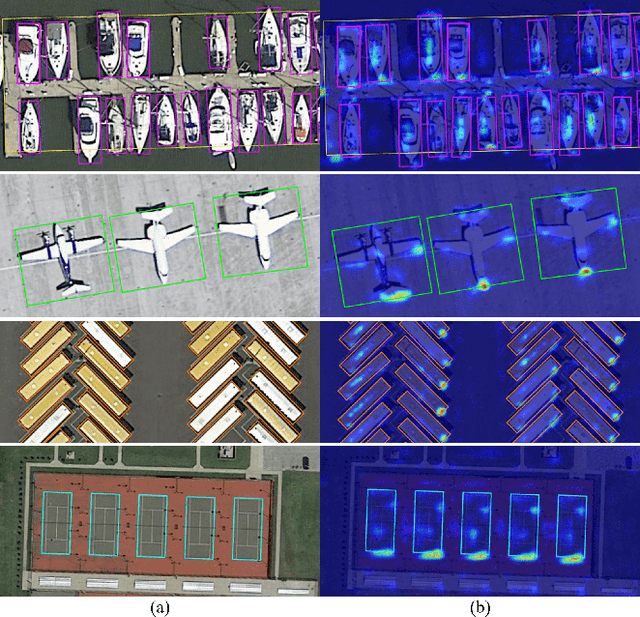
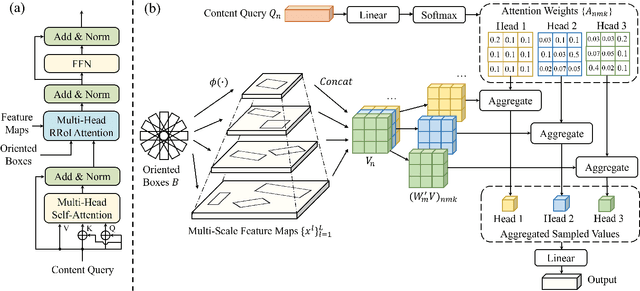
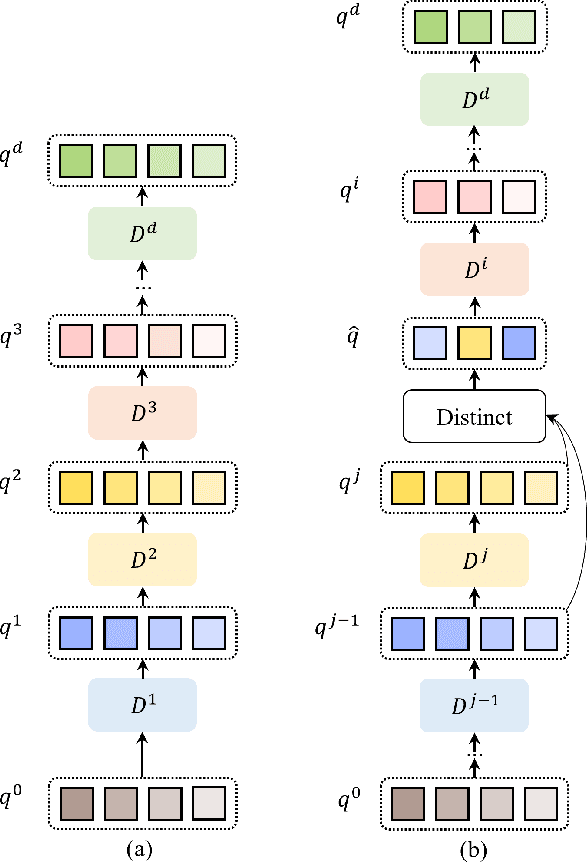
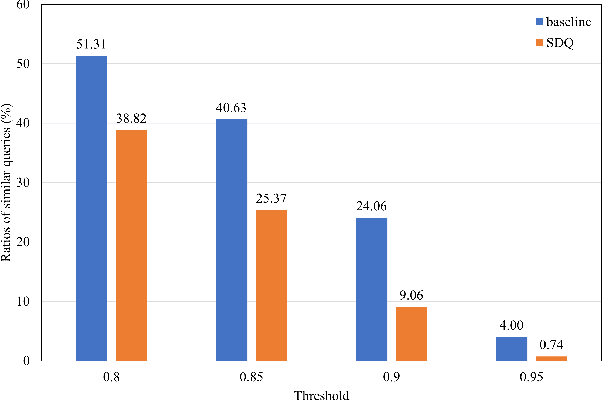
Abstract:Object instances in remote sensing images often distribute with multi-orientations, varying scales, and dense distribution. These issues bring challenges to end-to-end oriented object detectors including multi-scale features alignment and a large number of queries. To address these limitations, we propose an end-to-end oriented detector equipped with an efficient decoder, which incorporates two technologies, Rotated RoI attention (RRoI attention) and Selective Distinct Queries (SDQ). Specifically, RRoI attention effectively focuses on oriented regions of interest through a cross-attention mechanism and aligns multi-scale features. SDQ collects queries from intermediate decoder layers and then filters similar queries to obtain distinct queries. The proposed SDQ can facilitate the optimization of one-to-one label assignment, without introducing redundant initial queries or extra auxiliary branches. Extensive experiments on five datasets demonstrate the effectiveness of our method. Notably, our method achieves state-of-the-art performance on DIOR-R (67.31% mAP), DOTA-v1.5 (67.43% mAP), and DOTA-v2.0 (53.28% mAP) with the ResNet50 backbone.
A unified framework for STAR-RIS coefficients optimization
Oct 13, 2023Abstract:Simultaneously transmitting and reflecting (STAR) reconfigurable intelligent surface (RIS), which serves users located on both sides of the surface, has recently emerged as a promising enhancement to the traditional reflective only RIS. Due to the lack of a unified comparison of communication systems equipped with different modes of STAR-RIS and the performance degradation caused by the constraints involving discrete selection, this paper proposes a unified optimization framework for handling the STAR-RIS operating mode and discrete phase constraints. With a judiciously introduced penalty term, this framework transforms the original problem into two iterative subproblems, with one containing the selection-type constraints, and the other subproblem handling other wireless resource. Convergent point of the whole algorithm is found to be at least a stationary point under mild conditions. As an illustrative example, the proposed framework is applied to a sum-rate maximization problem in the downlink transmission. Simulation results show that the algorithms from the proposed framework outperform other existing algorithms tailored for different STAR-RIS scenarios. Furthermore, it is found that 4 or even 2 discrete phases STAR-RIS could achieve almost the same sum-rate performance as the continuous phase setting, showing for the first time that discrete phase is not necessarily a cause of significant performance degradation.
CT-Net: Arbitrary-Shaped Text Detection via Contour Transformer
Jul 25, 2023



Abstract:Contour based scene text detection methods have rapidly developed recently, but still suffer from inaccurate frontend contour initialization, multi-stage error accumulation, or deficient local information aggregation. To tackle these limitations, we propose a novel arbitrary-shaped scene text detection framework named CT-Net by progressive contour regression with contour transformers. Specifically, we first employ a contour initialization module that generates coarse text contours without any post-processing. Then, we adopt contour refinement modules to adaptively refine text contours in an iterative manner, which are beneficial for context information capturing and progressive global contour deformation. Besides, we propose an adaptive training strategy to enable the contour transformers to learn more potential deformation paths, and introduce a re-score mechanism that can effectively suppress false positives. Extensive experiments are conducted on four challenging datasets, which demonstrate the accuracy and efficiency of our CT-Net over state-of-the-art methods. Particularly, CT-Net achieves F-measure of 86.1 at 11.2 frames per second (FPS) and F-measure of 87.8 at 10.1 FPS for CTW1500 and Total-Text datasets, respectively.
TextDCT: Arbitrary-Shaped Text Detection via Discrete Cosine Transform Mask
Jun 27, 2022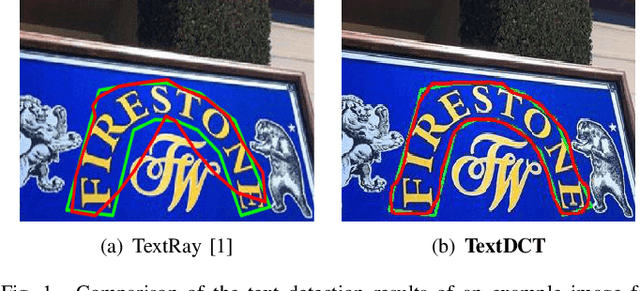
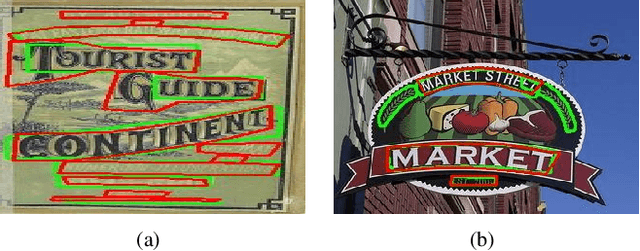
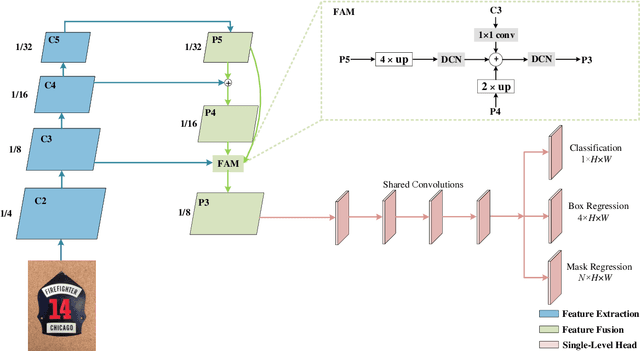
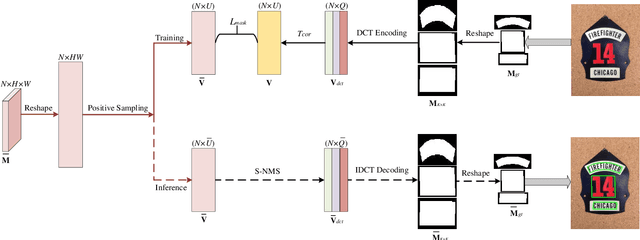
Abstract:Arbitrary-shaped scene text detection is a challenging task due to the variety of text changes in font, size, color, and orientation. Most existing regression based methods resort to regress the masks or contour points of text regions to model the text instances. However, regressing the complete masks requires high training complexity, and contour points are not sufficient to capture the details of highly curved texts. To tackle the above limitations, we propose a novel light-weight anchor-free text detection framework called TextDCT, which adopts the discrete cosine transform (DCT) to encode the text masks as compact vectors. Further, considering the imbalanced number of training samples among pyramid layers, we only employ a single-level head for top-down prediction. To model the multi-scale texts in a single-level head, we introduce a novel positive sampling strategy by treating the shrunk text region as positive samples, and design a feature awareness module (FAM) for spatial-awareness and scale-awareness by fusing rich contextual information and focusing on more significant features. Moreover, we propose a segmented non-maximum suppression (S-NMS) method that can filter low-quality mask regressions. Extensive experiments are conducted on four challenging datasets, which demonstrate our TextDCT obtains competitive performance on both accuracy and efficiency. Specifically, TextDCT achieves F-measure of 85.1 at 17.2 frames per second (FPS) and F-measure of 84.9 at 15.1 FPS for CTW1500 and Total-Text datasets, respectively.
MetaIQA: Deep Meta-learning for No-Reference Image Quality Assessment
Apr 11, 2020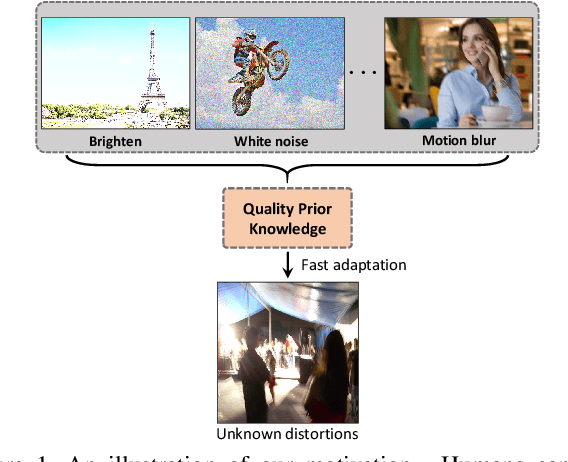

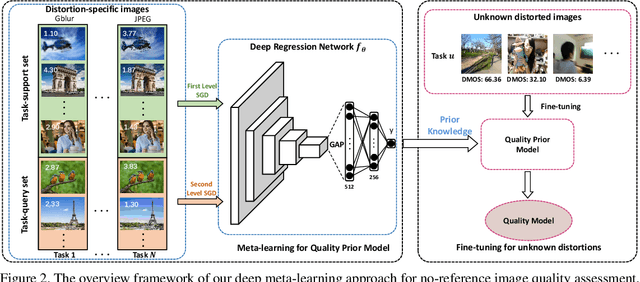
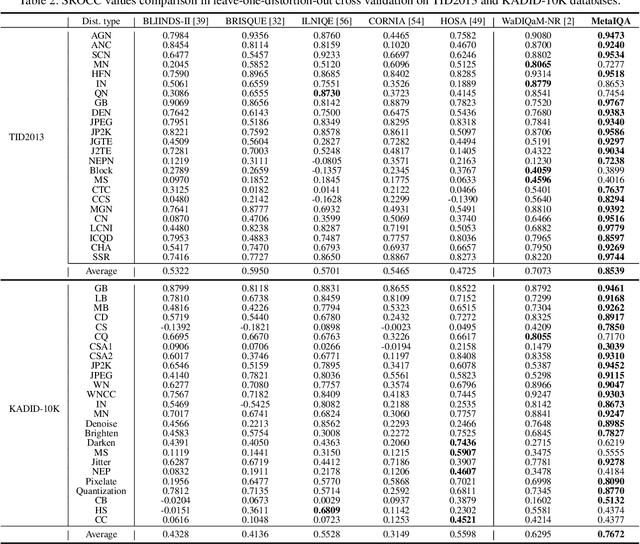
Abstract:Recently, increasing interest has been drawn in exploiting deep convolutional neural networks (DCNNs) for no-reference image quality assessment (NR-IQA). Despite of the notable success achieved, there is a broad consensus that training DCNNs heavily relies on massive annotated data. Unfortunately, IQA is a typical small sample problem. Therefore, most of the existing DCNN-based IQA metrics operate based on pre-trained networks. However, these pre-trained networks are not designed for IQA task, leading to generalization problem when evaluating different types of distortions. With this motivation, this paper presents a no-reference IQA metric based on deep meta-learning. The underlying idea is to learn the meta-knowledge shared by human when evaluating the quality of images with various distortions, which can then be adapted to unknown distortions easily. Specifically, we first collect a number of NR-IQA tasks for different distortions. Then meta-learning is adopted to learn the prior knowledge shared by diversified distortions. Finally, the quality prior model is fine-tuned on a target NR-IQA task for quickly obtaining the quality model. Extensive experiments demonstrate that the proposed metric outperforms the state-of-the-arts by a large margin. Furthermore, the meta-model learned from synthetic distortions can also be easily generalized to authentic distortions, which is highly desired in real-world applications of IQA metrics.
 Add to Chrome
Add to Chrome Add to Firefox
Add to Firefox Add to Edge
Add to Edge